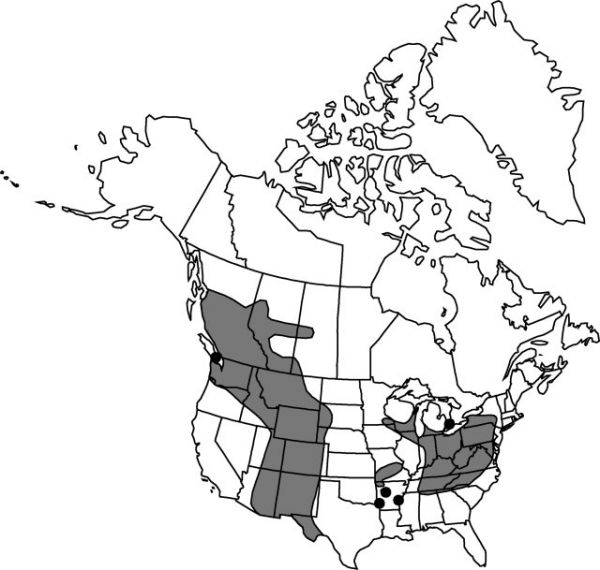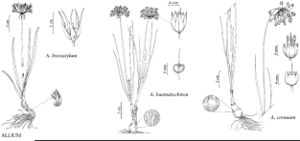Allium cernuum
Arch. Bot. (Leipzig) 1: 40. 1798.
Bulbs 2–5+, clustered, often short-rhizomatous at base, rhizome not stout or iris-like, oblong, elongate, 1–3 × 0.8–1.5 cm; outer coats enclosing 1 or more bulbs, grayish or brownish, membranous, minutely striate, cells in regular vertical rows, narrowly elongate, fibers persistent, parallel, few; inner coats white to pink or reddish, cells in regular vertical rows, narrowly elongate. Leaves persistent, green at anthesis, 3–5, basally sheathing, sheaths not extending much above soil level; blade solid, flat, channeled to broadly V-shaped in cross section, 10–25 cm × 1–6 mm, margins entire or denticulate. Scape persistent, sometimes 2 or more produced successively from single bulb, usually clustered, nodding, solid, terete or ridged, particularly distally, sometimes flattened and narrowly winged, abruptly recurved near apex, 10–50 cm × 1–3 mm. Umbel persistent, cernuous, loose, 8–35-flowered, hemispheric, bulbils unknown; spathe bracts persistent, 2, 3-veined, lanceolate, ± equal, apex acuminate, beakless. Flowers campanulate, 4–6 mm; tepals ± erect, pink or white, elliptic-ovate, ± equal, withering in fruit, margins ± entire, apex ± obtuse, at least outer tepals strongly incurved, midribs not thickened; stamens exserted; anthers yellow; pollen yellow; ovary conspicuously crested; processes 6, flattened, ± triangular, margins entire or toothed; style exserted, linear, ± equaling stamens; stigma capitate, scarcely thickened, unlobed; pedicel 6–25 mm, becoming stouter in fruit, elongating and bending abruptly upward from near point of attachment. Seed coat dull or shining; cells smooth, minutely roughened, or each with minute, central papilla. 2n = 14.
Phenology: Flowering Jul–Oct.
Habitat: Widely distributed on moist soils in mountainous and cool regions
Elevation: 600–3500 m
Distribution

Alta., B.C., Ont., Sask., Ala., Ariz., Ark., Colo., D.C., Ga., Idaho, Ill., Ind., Iowa, Ky., Md., Mich., Minn., Mo., Mont., Nebr., N.Mex., N.Y., N.C., Ohio, Oreg., Pa., S.C., S.Dak., Tenn., Tex., Utah, Va., Wash., W.Va., Wis., Wyo., Mexico.
Discussion
Allium cernuum is the most widespread North American species of the genus. It is closely related to A. stellatum, and the character commonly used to differentiate them has been umbel orientation. In both species, the inflorescence is nodding in bud, but in A. stellatum it usually becomes erect by anthesis. In A. cernuum the peduncle remains permanently recurved near the apex, although the inflorescence may sometimes become erect overall, or nearly so. While this character is helpful in identification, an almost exclusive reliance on it (even by one of the present authors in his youth) has obscured other clearer distinctions between the species and has confused their geographic ranges. More reliable characters for differentiating these species are bulb shape (elongate in A. cernuum, ovoid in A. stellatum) and perianth shape (campanulate in A. cernuum, stellate in A. stellatum). Unfortunately, perianth shape is often difficult to see in herbarium specimens.
Selected References
None.
